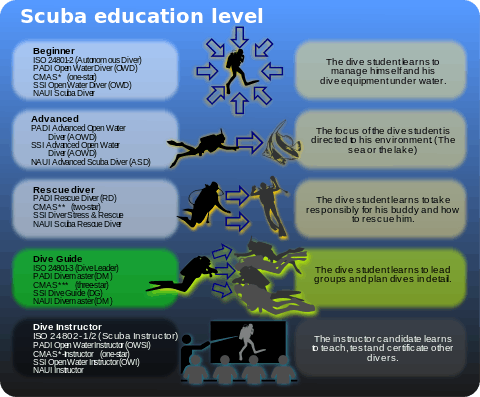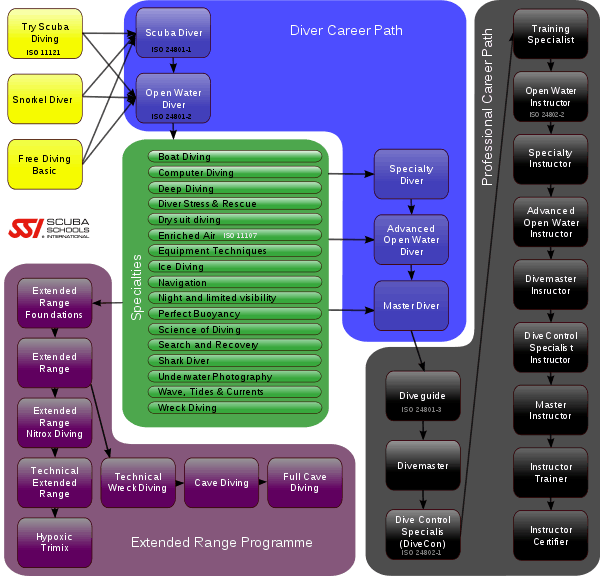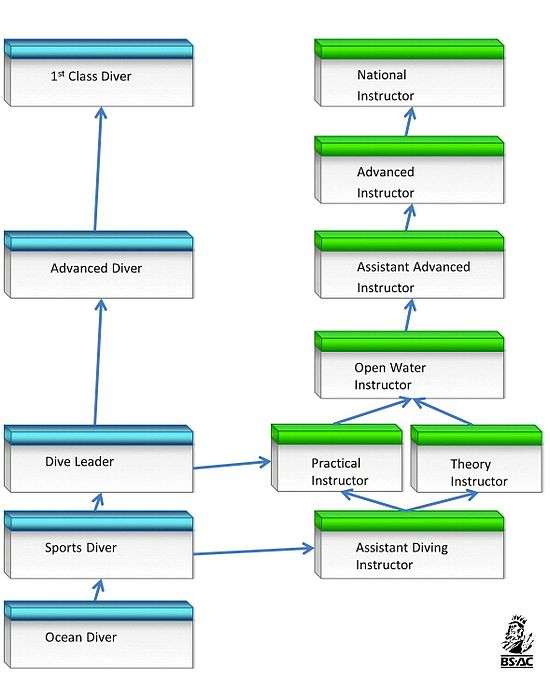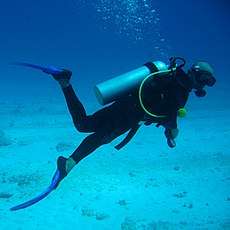Recreational diver training

.jpg)
Recreational diver training is the process of developing knowledge and understanding of the basic principles, and the skills and procedures for the use of scuba equipment so that the diver is able to dive for recreational purposes with acceptable risk using the type of equipment and in similar conditions to those experienced during training.
Not only is the underwater environment hazardous but the diving equipment itself can be dangerous. There are problems that divers must learn to avoid and manage when they do occur. Divers need repeated practice and a gradual increase in challenge to develop and internalise the skills needed to control the equipment, to respond effective if they encounter difficulties, and to build confidence in their equipment and themselves. Diver practical training starts with simple but essential procedures, and builds on them until complex procedures can be managed effectively. This may be broken up into several short training programmes, with certification issued for each stage,[1] or combined into a few more substantial programmes with certification issued when all the skills have been mastered.[2][3]
Many diver training organizations exist, throughout the world, offering diver training leading to certification: the issuing of a "Diving Certification Card," also known as a "C-card," or qualification card. This diving certification model originated at Scripps Institution of Oceanography in 1952 after two divers died while using university-owned equipment and the SIO instituted a system where a card was issued after training as evidence of competence.[4][5] Diving instructors affiliated to a diving certification agency may work independently or through a university, a dive club, a dive school or a dive shop. They will offer courses that should meet, or exceed, the standards of the certification organization that will certify the divers attending the course. The International Organization for Standardization has approved six recreational diving standards that may be implemented worldwide, and some of the standards developed by the (United States) RSTC are consistent with the applicable ISO Standards:[6]
The initial open water training for a person who is medically fit to dive and a reasonably competent swimmer is relatively short. Many dive shops in popular holiday locations offer courses intended to teach a novice to dive in a few days, which can be combined with diving on the vacation.[1] Other instructors and dive schools will provide more thorough training, which generally takes longer.[3] Dive operators, dive shops, and cylinder filling stations may refuse to allow uncertified people to dive with them, hire diving equipment or have their diving cylinders filled. This may be an agency standard, company policy, or specified by legislation.[7]
Training providers
Many diver training organizations exist, throughout the world, offering diver training leading to certification: the issuing of a "Diving Certification Card," also known as a "C-card," or qualification card. This diving certification model originated at Scripps Institution of Oceanography in 1952 after two divers died while using university-owned equipment and the SIO instituted a system where a card was issued after training as evidence of competence.[4][5]
Diving instructors affiliated to a diving certification agency may work independently or through a university, a dive club, a dive school or a dive shop. They will offer courses that should meet, or exceed, the standards of the certification organization that will certify the divers attending the course.
Duration of training
Recreational diver training courses range from minor specialties which require one classroom session and an open water dive, and which may be completed in a day, to complex specialties which may take several days to weeks, and require several classroom sessions, confined water skills training and practice, and a substantial number of open-water dives, followed by rigorous assessment of knowledge and skills. Details on the approximate duration of training can be found on the websites of most certification agencies, but accurate schedules are generally only available from the specific school or instructor who will present that course, as this will depend on the local conditions and other constraints.
The initial open water training for a person who is medically fit to dive and a reasonably competent swimmer is relatively short. Many dive shops in popular holiday locations offer courses intended to teach a novice to dive in a few days, which can be combined with diving on the vacation. Other instructors and dive schools will provide more thorough training, which generally takes longer.
Location of training lessons
Initial training typically takes place in three environments:
- Classroom - where material is presented and reviewed
- Confined Water (Swimming pool or equivalent natural body of water) - where skills are taught and initially practiced.
- Open Water - where the student demonstrates and refines the skills he or she has learned.
The usual sequence for learning most diving skills is to be taught the theory in the classroom, be shown the skill and practice in a swimming pool or sheltered and shallow open water using the minimum equipment, then practice again in open water under supervision in full equipment and only then use the skill on real dives. Typically, early open water training takes place in a local body of water such as a lake, a flooded quarry or a sheltered and shallow part of the sea. Advanced training mostly takes place at depths and locations similar to the diver's normal diving locations.
Training topics




Most entry-level training is similar across the diver training agencies, although some may emphasize certain topics earlier in the program, such as the inclusion of diver rescue in syllabuses such as CMAS 1* and NAUI,[2][8][9] and its absence from other equivalent courses such as PADI Open Water Diver.[1]
- Basic diving theory:
- Basic water skills:
- Finning and mobility in-water
- Fitting and wearing a diving mask
- Snorkeling
- Shallow free-diving
- Entering and exiting the water (seated entry, ladder exit, giant step entry, etc.)
- Basic open circuit scuba equipment skills:
- Preparing the scuba equipment
- Pre-dive checks:
- Water entries and exits with scuba gear
- Breathing from scuba equipment
- Buoyancy control trim and stability using weights, the Buoyancy Compensator and the lungs
- Underwater mobility and maneuvering
- Ascents and descents
- Diving mask clearing
- Demand valve clearing and recovery
- Air sharing
- Emergency ascents
- Basic rebreather diving skills:
- Preparing the Rebreather
- Buoyancy control using the Rebreather
- Ascents and descents
- Diving mask clearing and mouthpiece draining
- Bailing out to an alternative breathing gas supply
- Bail out ascent
- Diluent flush
- Dive planning skills:
- Buddy system
- Use of decompression tables
- Use of Dive computers
- Breathing gas requirement calculations
- Dive risk assessment:
- Safe dive site selection
- Choosing appropriate equipment
- Precautions for night diving and drift diving
- Dive leading skills:
- Depth and time discipline
- Air management
- Use of surface marker buoys
- Use of decompression buoys
- Use of distance lines
- Use of diving shots
- Compass navigation
- Underwater pilotage
- Doing decompression stops
- Diver rescue techniques:
- Controlled buoyant lift
- Towing a diver and landing a casualty
- In-water artificial respiration
- CPR on land
- Oxygen first aid on land
- General First aid
- Technical diving techniques:
- Using Nitrox as a bottom gas
- Analyzing proportion of oxygen in a breathing gas
- Calculating maximum operating depth of a breathing gas
- Calculating equivalent air depth of a breathing gas
- Using Nitrox as a decompression gas
- Planning accelerated decompression stops
- Normoxic Trimix as a bottom gas
- Hypoxic Trimix as a bottom gas
- Using Nitrox as a bottom gas
- Vocational techniques:
- Cave diving techniques
- Wreck penetration
- Underwater photography
- Underwater videography
- Underwater archeology
- Marine life identification
- Marine biology
- Dive group leading skills:
- Selecting dive sites using nautical charts
- Tides and use of tide tables
- Weather influences and prediction
- Group diver rescue management techniques
- Dive group safety, prevention and supervision
- Underwater search and recovery skills
- Underwater survey skills
- Logistical skills:
- Boat handling and seamanship
- Boat navigation and position fixing
- Diving air compressor operation
- Gas blending
- Use of group equipment such as diving shots and decompression trapezes
- Recompression chamber operation
- Instructor skills:
- Teaching diving theory
- Teaching personal diving skills
- Teaching group diving, safety and rescue skills
- Teaching boat handling, seamanship and navigation skills
- Teaching instructing skills
Scuba training for younger people
Most training agencies have minimum ages for diving and often restrict younger children to snorkeling. BSAC allows 6-year-olds to train for the "Dolphin Snorkeller" grade.[10]
From the age of 8 years old PADI has the "SEAL Team program" and SSI have "SCUBA Rangers" [11] which teach diving in shallow swimming pools.
PADI allows 10-year-olds to do the full Open Water Diver course. They are called "Junior Open Water" divers.[12] There are restrictions on their depth and group size when diving. Also they must dive with their parents or a professional. When they reach the age of 12 they can dive with a qualified adult. Over 15 they are considered capable of diving with others of the same age or above.
BSAC allows 12-year-olds to do the full entry level diving course - the Ocean Diver course.[13] This qualification has no restrictions for the young diver, but individual branches of BSAC are free to set their own minimum age for branch membership.
International standards equivalence
The International Organization for Standardization has approved six recreational diving standards that may be implemented worldwide (January 2007).
The listed standards developed by the (United States) RSTC are consistent with the applicable ISO Standards:[6]
| (USA) RSTC Standard | ISO Standard | Alternative ISO Title |
|---|---|---|
| Introductory Scuba Experience | No equivalent | |
| No equivalent | Level One Diver [14] | Supervised Diver |
| Open Water Diver | Level Two Diver[14] | Autonomous Diver |
| Dive Supervisor | Level Three Diver[14] | Dive Leader |
| Assistant Instructor | Level 1 Instructor[14] | |
| Scuba Instructor | Level 2 Instructor[14] | |
| Instructor Trainer | No equivalent | |
| No equivalent | Service Provider[14] |
See also
References
- 1 2 3 PADI (2010). PADI Instructor Manual. Rancho Santa Margarita, CA: USA: PADI.
- 1 2 "C.M.A.S. Diver Training Program" (PDF). Confédération Mondiale des Activités Subaquatiques. 2005-01-18. pp. 4, 6. Archived from the original (PDF) on 2011-07-19. Retrieved 2009-09-23. 1 T 10 and 1 P 6 cover rescue.
- 1 2 Staff (2011). "1.2 Training Philosophy". General Training Standards, Policies, and Procedures. Version 6.2. Global Underwater Explorers.
- 1 2 Manual for Diving Safety (PDF) (11th ed.). San Diego: Scripps Institution of Oceanography, University of California. 2005. p. 2. Archived from the original (PDF) on 2012-04-26.
- 1 2 "Scripps Institution of Oceanography Diver Certification". SIO. 2011. Archived from the original on 2012-04-26. Retrieved 2011-12-13.
- 1 2 Staff, WRSTC (2013) ISO approves 6 Diving Standards "Archived copy". Archived from the original on 2013-10-03. Retrieved 2013-09-28. retrieved 28 September 2013
- ↑ "Recreational diving Act, 1979" (in Hebrew). Knesset. 1979. Retrieved 16 November 2016 – via WikiSource.
- ↑ NAUI. "Scuba Diver Course". NAUI. Retrieved 26 December 2011.
- ↑ NAUI (2010). NAUI Standards and Procedures. Tampa, FL, USA: NAUI.
- ↑ "Snorkel Grade Training". BSAC. Retrieved 29 September 2013.
- ↑ http://www.divessi.com/about_rgr
- ↑ http://www.padi.com/scuba/padi-courses/diver-level-courses/view-all-padi-courses/open-water-diver/default.aspx
- ↑ http://www.bsac.com/page.asp?section=945§ionTitle=Always+wanted+to+learn+to+dive
- 1 2 3 4 5 6 Staff. "Standards for Training Organisations/System". EUF Certification International. Retrieved 28 September 2013.
External links
Scuba Diver Training Agencies at Curlie (based on DMOZ)

